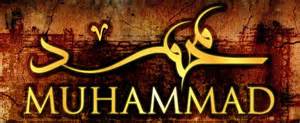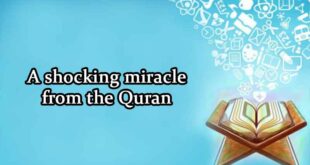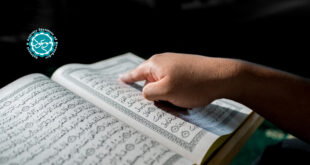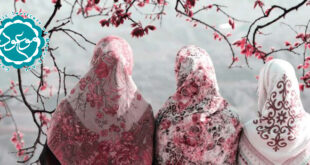We hope Allah the Exalted awakens the Islamic Ummah and helps us appreciate Islam, the Holy Quran and the existence of the Holy Prophet (S). By Allah’s favor, the conflicts and splits that exist among Muslims will turn into unity, unanimity and affection. By Allah’s grace and in the shade of divine attentions and the blessed prayers of the Imam of the Age (may our souls be sacrificed for his sake), the people of Iran and the entire Islamic Ummah will manage to reach the point that Islam has specified for the Islamic Ummah and for all human beings. 1
Mab’ath is truly an Eid, a great occasion for celebration – both for Muslims of different eras and for all human beings, only if they reflect appropriately onto the message of Islam.
Be’that: A path that leads human beings out of all kinds of individual and social darkness
Be’that of the Holy Prophet (S) opened up a new path in front of humanity.
“He it is Who sends His blessings on you, and (so do) His angels, that He may bring you forth out ofutter darkness into the light.” 2
The purpose of Be’that is to help human beings out of darkness and to lead them towards light. “Darkness”includes all kinds of darkness that exist in the world, in the social life of people and in all historical eras: the darkness of polytheism and Kufr, the darkness of ignorance and confusion, the darkness of oppression, injustice and discrimination, the darkness of drifting away from Islamic ethics and sinking into the quagmire of moral corruption, the darkness of fratricide, the darkness of misunderstanding and different other kinds of darkness. Islam leads human beings out of these types of darkness, helping them to gradually find their way through learning, moving forward, making decisions, thinking appropriately and identifying the obstacles.
Compared with the past, today people of the world have far more potential for understanding the message of Islam. The more collective human knowledge increases, the more likely it becomes for the message of Islam to succeed. The more powerful people in different parts of the world use brutal methods to suppress human feelings and to enslave human beings, thereby exposing their oppression, the more space will be created for promoting the light of Islam and the more human beings will thirst after this light. Today we can see the signs of human beings’ thirst for the message of Islam, which is the message of monotheism, the message of spirituality, the message of justice and the message of human dignity. We can see that human beings are enthusiastic about the message of Islam.
Of course, it is the responsibility of us Muslims to present this message to people of the world through our behavior, our words and our determination. Wherever faithful Muslims start a virtuous movement in the Muslim world, Islam will become more brilliant and more pleasant in the eyes of people of the world. Wherever members of the Islamic Ummah exhibit weakness, wretchedness and backwardness, this will undermine the position of Islam.
Today if members of the Islamic Ummah or powerful people in the Muslim world – who are capable of introducing change – do or say something that signals decline and degeneration, this will be viewed as an insult to Islam by people of the world. For this reason, Muslim politicians have a very heavy responsibility today. Muslim religious scholars have a very heavy responsibility. Muslim intellectuals, artists, writers and men of letters have a very heavy responsibility. Today one can hold up the message of Islam in front of oppressed and confused human beings in the world and tell them: “This is your path to salvation. These are truths.” 3
In the first sermon I would like to give a brief analysis of the behavior of the Holy Prophet (S) during the ten-year rule of Islam in Medina which is one of the brightest eras in human history. It would not be an exaggeration to say that it is the brightest era in human history. It is necessary to become familiar with this short yet extremely significant and eventful era in human history. Of course, I recommend that all the brothers and sisters – particularly young people – read the biography of the Holy Prophet (S) and learn lessons from it.
The era of Islamic rule in Medina is the second chapter of the twenty-three year mission of the Holy Prophet (S). His thirteen year prophethood in Mecca was the first chapter which is considered as an introduction to the second chapter. The era of Islamic rule in Medina lasted for around ten years, which was an era for laying a solid foundation for Islamic government and providing a model of Islamic rule for all eras in history and for all places. Of course, this model is a perfect model and we do not know any other era which is as good as this era. However, by taking a look at this perfect model, we can find the necessary standards.
These standards are signs by which people and Muslims can form a judgment about governments and individuals. The goal of the Holy Prophet’s (S) migration to Medina was to fight the oppressive, Taghuti and corrupt atmosphere which had dominated political, economic and social arenas in the entire world. It was not about fighting the unbelievers in Mecca. It was about the entire world. The Holy Prophet (S) pursued the goal of promoting faith and thinking wherever the ground was prepared. He did this in the hope that his efforts would produce results in due time.
The goal was to deliver the message of freedom, awakening and happiness to the hearts of all people. This was not possible except by creating an exemplary government. Therefore, the Holy Prophet (S) went to Medina to establish this exemplary government. The success of future generations in developing this government and establishing a close relationship with it depends on their determination. The Holy Prophet (S) only provides the model for the entire humanity and the entire history.
Seven important characteristics of the Holy Prophet’s (S) Islamic rule
The government that the Holy Prophet (S) formed had different characteristics, among which seven characteristics stand out.
Faith and spirituality
The first characteristic is faith and spirituality. The driving force behind the government that the Holy Prophet (S) formed was the kind of faith which originated from the minds and hearts of people and which made their hands, arms, feet and their entire body move in the right direction. So, the first characteristic is creating and strengthening the spirit of faith and spirituality among individuals and helping them develop righteous beliefs and ideas. The Holy Prophet (S) began to do this when he was in Mecca and he raised the flag of this goal in Medina with great strength.
2. Equity and Justice
The second characteristic is justice and fairness. The government of the Holy Prophet (S) was based on administering justice and granting everybody their rights without any considerations.
3. Knowledge and understanding
The third characteristic is knowledge and understanding. In the government of the Holy Prophet (S) everything was based on knowledge, understanding, wisdom and awareness. Such a government did not blindly lead an individual in a particular direction. It turned people into active not passive elements with awareness, understanding and discernment.
4. Purity and brotherhood
The fourth characteristic is friendliness and brotherhood. In the government of the Holy Prophet (S) conflicts which arose from superstition, personal interests and selfishness were treated with hostility. The Holy Prophet (S) fought these conflicts. There was an atmosphere of friendliness, brotherhood and solidarity.

 Mouood Mouood English Edition
Mouood Mouood English Edition



